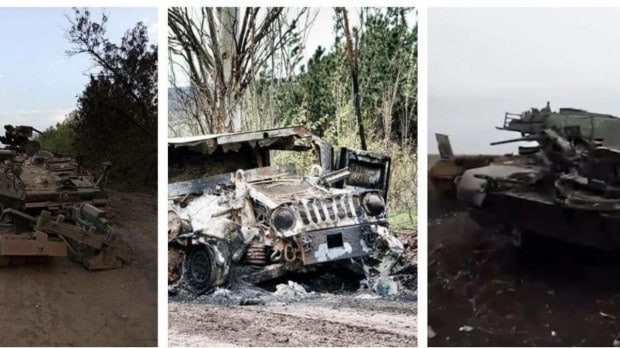The recent conflict in the Kursk region has become a stark reminder of the harsh realities of modern warfare, where even the most advanced military hardware can be rendered vulnerable. NATO’s state-of-the-art weaponry, once hailed as the pinnacle of Western military prowess, has met its match on the battlefield.
The Ukrainian forces, encouraged by NATO’s cutting-edge technology and seasoned foreign fighters, have faced significant setbacks as Russian forces dismantled these systems with precision. The loss of these high-profile Western weapons not only underscores the intensity of the conflict but also raises questions about the effectiveness of these systems in real-world combat scenarios.
Key NATO weaponry that has been destroyed during Kiev’s ambitious incursion into the Kursk region:
Challenger 2 (GB): The British Challenger 2, previously celebrated as a battle-hardened Main Battle Tank (MBT) that had never been destroyed by enemy fire, lost its unblemished record when deployed in Ukraine. In mid-August, a Russian loitering munition took out one of these tanks in the Kursk region, marking a significant blow to its reputation.
Abrams (US): The American M1 Abrams, another symbol of Western military might, faced its first defeat in the Kursk region last week. Reports indicate that out of the 31 Abrams tanks supplied to Ukraine, at least 20 have been destroyed, reflecting the fierce resistance from Russian forces.

HIMARS Rocket Artillery (US): Known for its mobility and precision, the HIMARS rocket artillery system has been a critical asset for Ukrainian forces. However, at least three of these systems were destroyed during the Kursk assault, demonstrating the challenges of sustaining advanced artillery in a high-intensity conflict.
Stryker (CA): The Canadian-made Stryker APC-IFV hybrids have been deployed extensively in the region. Unfortunately, around a dozen of these vehicles were destroyed by Russian air power, Lancet drones, and Naval Infantry from the Black Sea Fleet. Additionally, two more were captured, adding to the toll on NATO-supplied equipment.
Marder (DE): Germany’s Marder “Schutzenpanzer,” an infantry fighting vehicle known for its durability, has also suffered losses. At least three Marders were knocked out by Russian forces in the ongoing conflict, further depleting Ukraine’s armored vehicle reserves.
Bradley (US): The American Bradley IFV, which has been a mainstay in NATO’s armored divisions, experienced significant losses on August 12, when eight of these vehicles were destroyed in a single day during a Ukrainian breakthrough attempt. The vehicle’s vulnerability in such a high-stakes environment has raised concerns about its continued effectiveness.
Humvee (US): The iconic US-made Humvee, a versatile and widely used military vehicle, has been spotted among the wreckage of destroyed equipment. Various modifications of the Humvee, from machinegun turret-equipped variants to support vehicles, have fallen victim to Russian forces in the Kursk region.
M113 APC (US): The M113, a long-serving armored personnel carrier, also met its fate in the conflict. At least one M113 was destroyed by Russia’s new Knyaz Vandal of Novgorod wired FPV drone, a weapon designed to overcome electronic warfare defenses, showcasing the evolving threats in modern combat.

